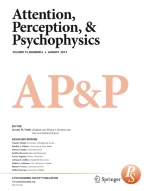Abstract
Three experiments investigated visual search for singleton feature targets. The critical dimension on which the target differed from the nontargets was either known in advance or unknown—that is, the critical difference varied eitherwithin a dimension oracross dimensions. Previous work (Treisman, 1988) had shown that, while the search reaction time (RT) functions were flat in both conditions, there was an intercept cost for the cross-dimension condition. Experiment 1 examined whether this cost would disappear when responses could be based on the detection ofany (target—nontarget) difference in the display (by requiring a “heterogeneity/homogeneity” decision). The cost remained. This argues that pop-out requires (or involves) knowledge of the particular dimension in which an odd-one-out target differs from the nontargets; furthermore, that knowledge is acquired through the elimination of dimensions not containing a target. In Experiment 2, the subjects had to eliminate (or ignore) one potential source of difference in order to give a positive response (displays could contain a “noncritical” difference requiring a negative response). The result was a comparatively large cost in the within-dimension (positive) condition. This can be taken to indicate that popout as such does not make available information as to the particular feature value in which the target differs from the nontargets. Experiment 3 examined whether search priorities can be biased in accordance with advance knowledge of the likely source of difference. The subjects were found to have a high degree of top-down control over what particular dimension to assign priority of checking to. The implication of the results for models of visual search and selection are discussed.
Article PDF
Similar content being viewed by others
Avoid common mistakes on your manuscript.
References
Bacon, W. F., &Egeth, H. E. (1994). Overriding stimulus-driven attentional capture.Perception & Psychophysics,55, 485–496.
Cave, K. R., &Wolfe, J. M. (1990). Modeling the role of parallel processing in visual search.Cognitive Psychology,22, 225–271.
Duncan, J., &Humphreys, G.W. (1989). Visual search and stimulus similarity.Psychological Review,96, 433–458.
Duncan, J., &Humphreys, G.W. (1992). Beyond the search surface: Visual search and attentional engagement.Journal of Experimental Psychology: Human Perception & Performance,18, 578–588.
Humphreys, G.W., &Müller, H. J. (1993). SEarch via Recursive Rejection (SERR): A connectionist model of visual search.Cognitive Psychology,25, 43–110.
Johnston, J. C., &Pashler, H. (1990). Close binding of identity and location in visual feature perception.Journal of Experimental Psychology: Human Perception & Performance,16, 843–856.
Koch, C., &Ullman, S. (1985). Shifts in selective visual attention: Towards the underlying neural circuitry.Human Neurobiology,4, 219–227.
Maljkovic, V., &Nakayama, K. (1994). Priming of popout: I. Role of features.Memory & Cognition,22, 657–672.
Monheit, M. A., &Johnston, J. C. (1994). Spatial attention to arrays of multidimensional objects.Journal of Experimental Psychology: Human Perception & Performance,20, 691–708.
Pashler, H. (1988). Cross-dimensional interaction and texture segregation.Perception & Psychophysics,43, 307–318.
Quinlan, P. T., &Humphreys, G.W. (1987). Visual search for targets defined by combinations of color, shape, and size: An examination of the task constraints on feature and conjunction searches.Perception & Psychophysics,41, 455–472.
Reiffenrath, D. (1993).Zur Merkmalsanalyse bei visuellen Suchaufgaben— ein simulationsgestützter Ansatz [Feature analysis in visual search: A simulation-based approach]. Doctoral dissertation, Rheinisch-Westfälische Technische Hochschule Aachen. Aachen: Shaker.
Sagi, D., &Julesz, B. (1985a). Detection versus discrimination of visual orientation.Perception,14, 619–628.
Sagi, D., &Julesz, B. (1985b). “Where” and “what” in vision.Science,228, 1217–1219.
Schneider, W., &Shiffrin, R. M. (1977). Controlled and automatic human information processing: I: Detection, search, and attention.Psychological Review,84, 1–66.
Theeuwes, J. (1991). Cross-dimensional perceptual selectivity.Perception & Psychophysics,50, 184–193.
Theeuwes, J. (1992). Perceptual selectivity for color and form.Perception & Psychophysics,51, 599–606.
Treisman, A. (1988). Features and objects: The fourteenth Bartlett memorial lectures.Quarterly Journal of Experimental Psychology,40A, 201–237.
Treisman, A., &Gelade, G. (1980). A feature-integration theory of attention.Cognitive Psychology,12, 97–136.
Treisman, A., &Gormican, S. (1988). Feature analysis in early vision: Evidence from search asymmetries.Psychological Review,95, 15–48.
Treisman, A., &Sato, S. (1990). Conjunction search revisited.Journal of Experimental Psychology: Human Perception & Performance,16, 459–478.
Wolfe, J. M. (1994). Guided Search 2.0: A revised model of visual search.Psychonomic Bulletin & Review,1, 202–238.
Yantis, S. (1993). Stimulus-driven attentional capture.Current Directions in Psychological Science,2, 156–161.
Author information
Authors and Affiliations
Department of Psychology, Birkbeck College (University of London), Malet Street, WC1E 7HX, London, UK
Hermann J. Müller
Rheinisch-Westfälische Technische Hochschule, Aachen, Germany
Dieter Heller & Johannes Ziegler
- Hermann J. Müller
You can also search for this author inPubMed Google Scholar
- Dieter Heller
You can also search for this author inPubMed Google Scholar
- Johannes Ziegler
You can also search for this author inPubMed Google Scholar
Corresponding author
Correspondence toHermann J. Müller.
Additional information
This research was supported by Science and Engineering Research Council Grant GR/H/54966 to H. Müller. It benefitted from remarks made by A. M. Jacobs and D. Reiffenrath (1993).
Rights and permissions
About this article
Cite this article
Müller, H.J., Heller, D. & Ziegler, J. Visual search for singleton feature targets within and across feature dimensions.Perception & Psychophysics57, 1–17 (1995). https://doi.org/10.3758/BF03211845
Received:
Accepted:
Issue Date:
Share this article
Anyone you share the following link with will be able to read this content:
Sorry, a shareable link is not currently available for this article.
Provided by the Springer Nature SharedIt content-sharing initiative



